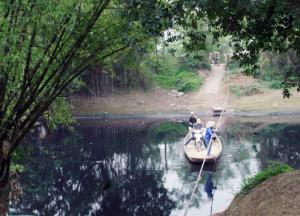Risky ferry trips in Hanoi

The boatman doesn’t use oars, but uses a wire that is stretched across the river to move the boat. Whenever there are passengers, the boatman holds the wire and pulls it to operate the ferry. This means of transport has been used for decades on Hanoi’s Nhue River.
Located less than 15 kilometers from Hanoi’s center, residents in the My Hung commune, Thanh Oai district, have been familiar with the above kind of ferry, called “đò dây”, which they use to go from My Hung to Ta Thanh Oai commune.
Local people said there are no bridges in this area. To cross the river, they have to use the Ta Thanh Oai Bridge, which is 6-7 kilometers away. To save time and fuel, most people choose “đò dây”. There are three “đò dây” wharves along 6 kilometers of the Nhue riverbank in the My Hung commune.
The ferry doesn’t use engines or oars at all, but instead a fabric-made wire tied to two concrete stakes which are buried on the two riverbanks. Boatmen hold firmly to the wire and hunch their back to pull to take the ferry across the river.
Most of ferries are made by reinforced concrete, covered by small pieces of wood on the surface and don’t have handrails. A ferry is priced from VND3-5 million ($150-250).
Nguyen Manh Dai, a boatman from Quang Minh village, who has worked for over 20 years on the Nhue River, said that he earns VND2-2.5 million a month. The ferry charge is only VND500-1,000/passenger with his/her vehicle.
In the dry season, the river is only 20 meter wide and the water smells. In the rainy season, water rises high. Ta Van Thuan, chief police officer of My Hung commune, said that they have had no fatal accidents caused by “đò dây” recorded so far. However, “đò dây” looks very dangerous in the rainy season.
Nguyen Van Mat, My Hung commune’s Chair, said the commune had asked ${bigcity_Hanoi:"Hanoi"} authorities to build a bridge and the city agreed.
This project will be kicked off in 2011.









